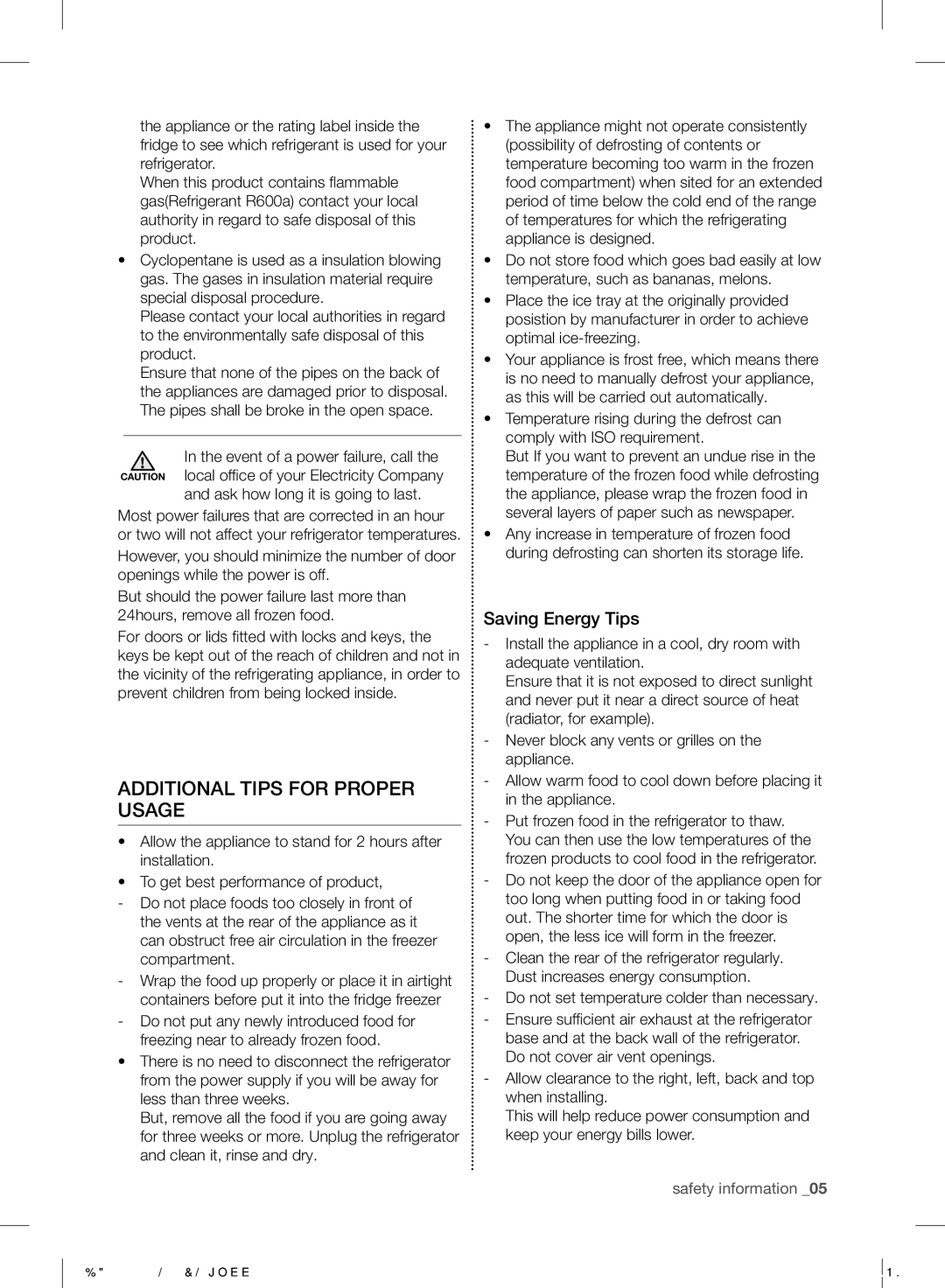
the appliance or the rating label inside the fridge to see which refrigerant is used for your refrigerator.
When this product contains fl ammable gas(Refrigerant R600a) contact your local authority in regard to safe disposal of this product.
•Cyclopentane is used as a insulation blowing gas. The gases in insulation material require special disposal procedure.
Please contact your local authorities in regard to the environmentally safe disposal of this product.
Ensure that none of the pipes on the back of the appliances are damaged prior to disposal. The pipes shall be broke in the open space.
![]() In the event of a power failure, call the CAUTION local offi ce of your Electricity Company
In the event of a power failure, call the CAUTION local offi ce of your Electricity Company
and ask how long it is going to last. Most power failures that are corrected in an hour or two will not affect your refrigerator temperatures. However, you should minimize the number of door openings while the power is off.
But should the power failure last more than 24hours, remove all frozen food.
For doors or lids fi tted with locks and keys, the keys be kept out of the reach of children and not in the vicinity of the refrigerating appliance, in order to prevent children from being locked inside.
ADDITIONAL TIPS FOR PROPER USAGE
•Allow the appliance to stand for 2 hours after installation.
•To get best performance of product,
-Do not place foods too closely in front of the vents at the rear of the appliance as it can obstruct free air circulation in the freezer compartment.
-Wrap the food up properly or place it in airtight containers before put it into the fridge freezer
-Do not put any newly introduced food for freezing near to already frozen food.
•There is no need to disconnect the refrigerator from the power supply if you will be away for less than three weeks.
But, remove all the food if you are going away for three weeks or more. Unplug the refrigerator and clean it, rinse and dry.
•The appliance might not operate consistently (possibility of defrosting of contents or temperature becoming too warm in the frozen food compartment) when sited for an extended period of time below the cold end of the range of temperatures for which the refrigerating appliance is designed.
•Do not store food which goes bad easily at low temperature, such as bananas, melons.
•Place the ice tray at the originally provided posistion by manufacturer in order to achieve optimal
•Your appliance is frost free, which means there is no need to manually defrost your appliance, as this will be carried out automatically.
•Temperature rising during the defrost can comply with ISO requirement.
But If you want to prevent an undue rise in the temperature of the frozen food while defrosting the appliance, please wrap the frozen food in several layers of paper such as newspaper.
•Any increase in temperature of frozen food during defrosting can shorten its storage life.
Saving Energy Tips
-Install the appliance in a cool, dry room with adequate ventilation.
Ensure that it is not exposed to direct sunlight and never put it near a direct source of heat (radiator, for example).
-Never block any vents or grilles on the appliance.
-Allow warm food to cool down before placing it in the appliance.
-Put frozen food in the refrigerator to thaw. You can then use the low temperatures of the frozen products to cool food in the refrigerator.
-Do not keep the door of the appliance open for too long when putting food in or taking food out. The shorter time for which the door is open, the less ice will form in the freezer.
-Clean the rear of the refrigerator regularly. Dust increases energy consumption.
-Do not set temperature colder than necessary.
-Ensure suffi cient air exhaust at the refrigerator base and at the back wall of the refrigerator. Do not cover air vent openings.
-Allow clearance to the right, left, back and top when installing.
This will help reduce power consumption and keep your energy bills lower.
safety information _05
2012.3.5 4:55:50 PM |
